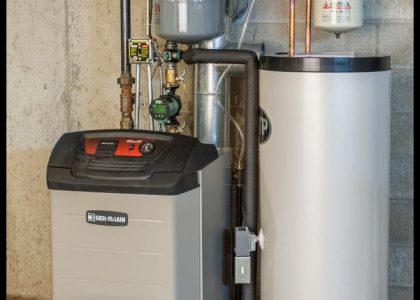A ‘Heating Cost Calculator’ is a very useful tool to compare the costs of various heating fuels. They typically convert each fuel into a “cost per million BTU’s’, the accepted industry common denominator. Additionally they usually allow varying input data to suit your particular situation. All well and good.
For reference please use the following links to follow this discussion:
Note: These are NH Sites (our locale). Similar ones should be available in your area, or adapt these.
The NH-OEP Home Page (first link) has a listing of current average fuel pricing in our area, dated and updated typically weekly. You will note these in the right column table on this page. The values are automatically downloaded into the Heating Cost Calculator (second link) in the Fuel Unit Cost column. The Heating Unit (assumed value) Efficiencies are displayed and the net Price per Million BTU displayed. Very nice.
Now you can ‘play the numbers’, selecting only those fuels of interest and availability, their local costs by solicitation, and applying your current and proposed heating appliance efficiencies. If only it was this easy.
Unfortunately both of these variables (Fuel Unit Cost and Heating Unit Efficiency) are not so clearly definable as we would assume. Let’s look at each one.
Fuel Unit Cost is the cost per respective unit of measure for that particular fuel. (A Gallon of Oil, A Cord of Wood, A Ton of Coal, A Therm of Natural Gas, etc.) We assume that it is the cost at your door, in your tank, through your pipe, etc. This is not necessarily so, particularly depending upon the type of fuel.
We must make a distinction immediately between a ‘DELIVERED FUEL’ and a ‘DISTRIBUTED FUEL’. A ‘Delivered Fuel” is one that is physically transported to your door vs. a ‘Distributed Fuel’ that is ‘piped’ through an external network. Natural Gas and Electricity are ‘Distributed Fuels’, the others are not. So why the distinction?
Distributed fuels are subject to other charges beyond their ‘unit cost’ and is the prompting for this writing. One of our customers is seasonally forwarding his Natural Gas billing that includes:
- The Cost per Therm, the number of Therms and the extended cost. (His ‘Gas Bill’.)
- A Minimum Daily Service Charge, regardless of usage.
- A significant ‘Distribution Charge’, presumably wear and tear on the pipes(?) (He operates a Weil-McLain Ultra Condensing Gas Boiler and 60 Gallon Indirect Water Heater at 93 to 98% (winter to summer cycles) in an older 3-Bedroom Cape, located in Central NH — about 7,500 Degree-Days, current year.)
Annualized Monthly Natural Gas Bill Summary: Summer (August) Billing: 55% consumption and 45% ‘other’ charges. Winter (January) Billing: 70% consumption and 30% ‘other’ charges. Estimated Annualized Burden: Approx. 33%
LESSON: Multiply Quoted Natural Gas ‘Per Therm’ Cost by 1.3 (Winter) or 1.45 (Summer) to reflect the actual seasonal cost per therm!
SUGGESTION: Get an estimate of annual fuel costs based on projected energy usage from your supplier(s) before commitment.
DISCLAIMER: We install and maintain Natural Gas, Propane and Oil-Fired Systems and have no personal interest excepting to advise the consumer.
We have not looked at electricity in this light since we have particularly high electric costs regionally, thus electric resistance heating and heat pumps are not popular in the frozen north. But in it’s case you should back out items like ‘stranded costs’ and the like to get to a true energy efficiency calculation.
Heating Unit Efficiency is our second variable in the Table and should be entered for your present appliance vs. other options, or if new construction only vs. the various options. How do we do these effectively?
The new appliance efficiency number is easy. Enter the AFUE (Annual Fuel Utilization Efficiency) percentage stated by the manufacturer. (We presume in selecting powered appliances that you are only opting for ‘Energy Star Rated’ equipment.
What about your present appliance? If it’s fairly new it may have an AFUE value on the Specification Tag or Label. If it’s ‘old enough to vote’, then it’s a different matter.
Many Heating Servicemen leave a Service Tag that denotes date, service items, notes and an ‘Efficiency’ calculation. You will see Draft, CO2 and Smoke values converted into an ‘Efficiency’. CAUTION! This is a ‘BURNER EFFICIENCY’ value and NOT ‘APPLIANCE EFFICIENCY’ as an AFUE value would reflect.
To arrive at an Appliance Efficiency for your older system would require converting ‘Exhaust or Stack Temperature’ of the exiting gases and relationships between heat exchanger areas vs. firing rates, etc. This is not the stuff you have available at the Serviceman Level to ascertain the equivalent of an AFUE. These are derived on Test Stands in Laboratories.
Suffice to say that your Service Tag Efficiency is NOT your Appliance Efficiency. Rule: The higher the exhaust temperature, the poorer the efficiency. As exhaust temps go up, efficiency drops dramatically! We won’t and can’t quote numbers, but look at new appliance specifications and take it from there.
We trust the enclosed will help you to make better fuel and appliance decisions.
Last Edit: 5/14/2012 pdm

